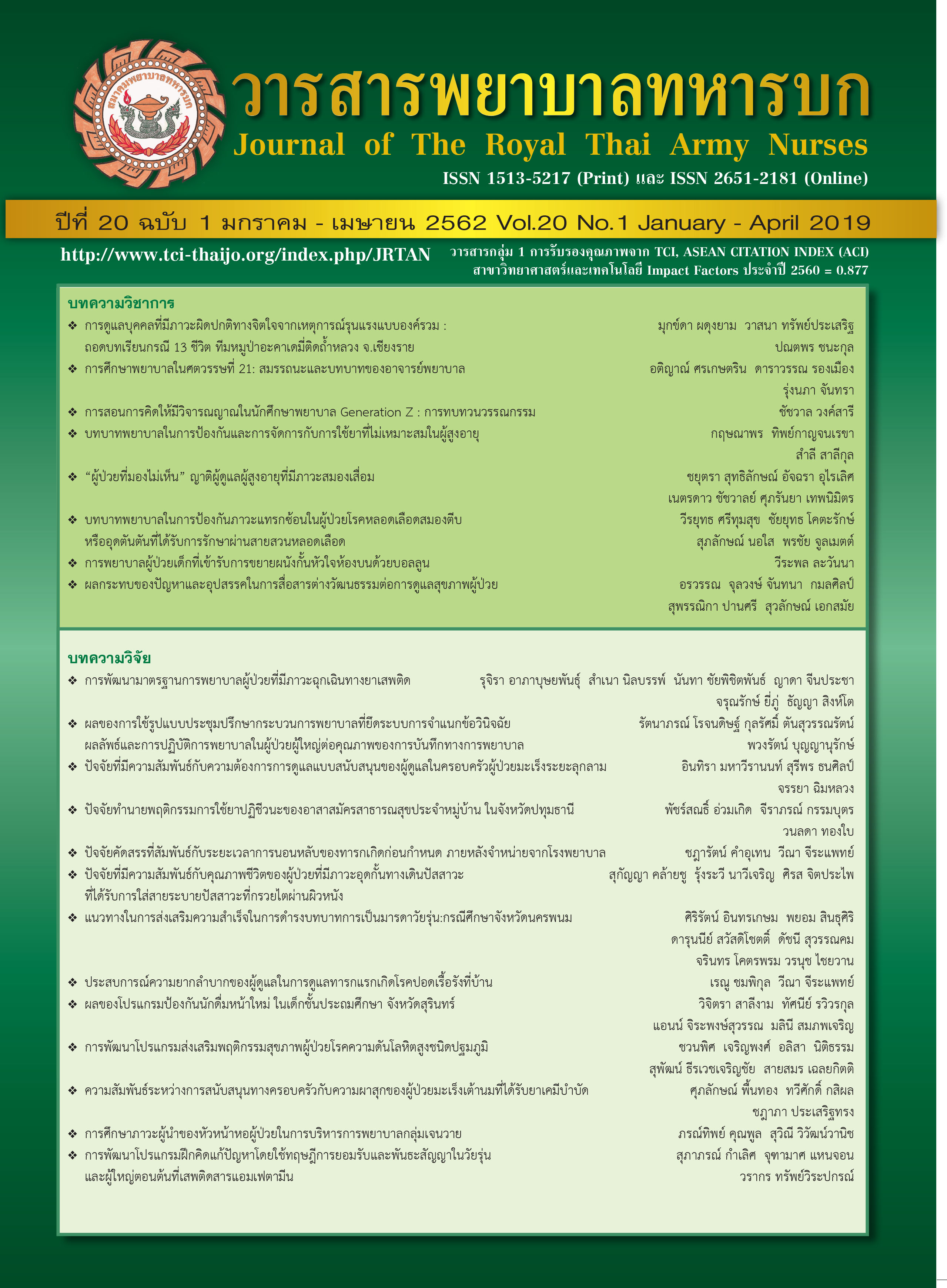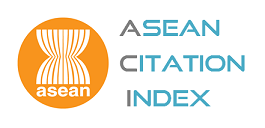การศึกษาภาวะผู้นำของหัวหน้าหอผู้ป่วย ในการบริหารการพยาบาลกลุ่มเจนวาย
คำสำคัญ:
ภาวะผู้นำ, หัวหน้าหอผู้ป่วย, พยาบาลกลุ่มเจนวายบทคัดย่อ
การวิจัยครั้งนี้มีวัตถุประสงค์เพื่อศึกษาภาวะผู้นำของหัวหน้าหอผู้ป่วยในการบริหารการพยาบาลกลุ่มเจนวาย โดยใช้ เทคนิคเดลฟาย ผู้ให้ข้อมูลเป็นผู้เชี่ยวชาญ จำนวน 19 คน ประกอบด้วย ผู้บริหารทางการพยาบาล จำนวน 3 คน หัวหน้าหอผู้ป่วย จำนวน 5 คน ผู้เชี่ยวชาญด้านการวางแผนทรัพยากรมนุษย์ จำนวน 1 คน นักวิชาการ/อาจารย์สอนการบริหารพยาบาล จำนวน 4 คน และพยาบาลเจนวาย จำนวน 6 คน วิธีดำเนินการวิจัยประกอบด้วย 3 ขั้นตอน โดยขั้นตอนที่ 1 สัมภาษณ์ผู้เชี่ยวชาญ เกี่ยวกับภาวะผู้นำของหัวหน้าหอผู้ป่วยในการบริหารการพยาบาลกลุ่มเจนวาย ขั้นตอนที่ 2 นำข้อมูลที่ได้จากการสัมภาษณ์มา วิเคราะห์สาระสำคัญแล้วนำมาสร้างแบบสอบถามให้ผู้เชี่ยวชาญแสดงความคิดเห็นเกี่ยวกับระดับความสำคัญของรายด้านย่อยของ ภาวะผู้นำของหัวหน้าหอผู้ป่วยในการบริหารการพยาบาลกลุ่มเจนวายและนำมาคำนวณค่ามัธยฐานและค่าพิสัยระหว่างควอไทล์ ขั้นตอนที่ 3 นำข้อมูลที่ได้จากขั้นตอนที่ 2 จัดทำเป็นแบบสอบถามให้ผู้เชี่ยวชาญยืนยันคำตอบและนำข้อมูลที่ได้มาคำนวณหาค่า มัธยฐานและค่าพิสัยระหว่างควอไทล์เพื่อสรุปผลการวิจัย ผลการวิจัยพบว่า ภาวะผู้นำของหัวหน้าหอผู้ป่วยในการบริหารการพยาบาล กลุ่มเจนวาย ประกอบด้วย 8 ด้าน และมีข้อรายการย่อย จำนวน 78 ข้อ ได้แก่ 1) ด้านคุณลักษณะของผู้นำ จำนวน 21 ข้อ 2) ด้าน วิสัยทัศน์ จำนวน 8 ข้อ 3) ด้านการเสริมแรงบันดาลใจ จำนวน 12 ข้อ 4) ด้านการบริการ จำนวน 6 ข้อ 5) ด้านการพัฒนา จำนวน 11 ข้อ 6) ด้านการบริหารความขัดแย้ง จำนวน 4 ข้อ 7) ด้านการนิเทศ จำนวน 7 ข้อ และ 8) ด้านเทคโนโลยีสารสนเทศ และการสื่อสาร จำนวน 9 ข้อ
Downloads
เอกสารอ้างอิง
Boonjai, S. Leadership and Strategic management in Nusing Organization forthe 21th Century. 2007. (in Thai)
Ministry of public health. Strategy and planning Division.2016. (in Thai)
Teaintong, H. Academic lecture document (incubation), cultivating love, creating relationships, Faculty of Nursing, Chiang Mai University. 2013.
Bencsik A., Horvath-Csikos G., & Juhasz T. Y and Z Generations at Workplaces. Journal of Competitiveness. 2016;8(3):90-106.
Rattanapitikorn, D. The predicted factor is a constant in the work of a professional nursing, Phyathai Hospital. A Thesis of Master degree, Nursing Science in Nursing Administration School of Nursing Sukhothai Thammathirat University. 2009.
Chupan, S. Generation Y Professional Nurses: A Challenge for Nursing Administrators. Nursing Journal of The Ministry of Public Health. 2018;28(1):1-12. (in Thai)
Maulik S. J, Bernard J. H. Healthcare transformation [electronic resource] : a guide for the hospital board member. Boca Raton : Taylor & Francis. 2009.
Patterson, K. A. Servant leadership: A theoretical model. Servant Leadership Roundtable. Regent University School of Leadership Studies, Virginia Beach. VA; 2003.
Spears, L. C. Character and Servant Leadership: Ten characteristics of effective, caring leaders. Journal of Virtues & Leadership.2010;1(1):25-30.
Richard, L. D. Leadership : theory and practice. Fort Worth, TX : Dryden Press.1999.
Laschinger, H. K. The influence of authentic leadership on newly graduated nurse’s experiences of workplace bullying, burnout and retention outcomes: A cross-sectional study. International Journal of Nursing Studies. 2012;49(1):1266-1276.
Werner, S. Human Resource Management. 11 rded. Canada: South-Western Cengage Learning. 2012.
Nittaya, S. Nursing Management. Praboromarajchanok institute nonthaburi. 2011. (in Thai)
Wharton, R. F. The impact of intuition and supervisor-nurse relationships on empowerment and affective commitment by generation. Journal of Advanced Nursing.2012;68(6) : 1391-1401.
Rattikorn, C .Leadership :Theories, Research, and Approaches to Development. 2015. (in Thai)
Spaho, K. Organizational communication and conflict management, Management. 2013; 18(1):103-118.
Jackson, S. E. Managing Human Resource. 1 sted. Canada: South-Western Cengage Learning. 2009.
Bruce, T. Not Everyone Gets a Trophy-How to Manage Generation Y. Jossey-Bass: USA; 2009.
Paworamon Tassanaananchai. The management characteristics of generation Y professional nurses. Kuakarun Journal of Nursing .2014;21(2): 126-138.
Priscilla Smith-Trudeau. Generation Z Nurses Have Arrived. Are you ready?. New Hampshire Nursing News.2016;13-14.
Nantsupawat A., Skulphan S., Sriteerajit G., Jindathum A., & Suochama P. Evaluation of Teaching by Teleconference:Leadership Development in Nursing Organization Course Case Study. Journal of the Royal Thai Army Nurses. 2018;19(2):183-190. (in Thai)
ดาวน์โหลด
เผยแพร่แล้ว
รูปแบบการอ้างอิง
ฉบับ
ประเภทบทความ
สัญญาอนุญาต
บทความหรือข้อคิดเห็นใดใดที่ปรากฏในวารสารพยาบาลทหารบกเป็นวรรณกรรมของผู้เขียน ซึ่งบรรณาธิการหรือสมาคมพยาบาลทหารบก ไม่จำเป็นต้องเห็นด้วย
บทความที่ได้รับการตีพิมพ์เป็นลิขสิทธิ์ของวารสารพยาบาลทหารบก
The ideas and opinions expressed in the Journal of The Royal Thai Army Nurses are those of the authors and not necessarily those
of the editor or Royal Thai Army Nurses Association.







